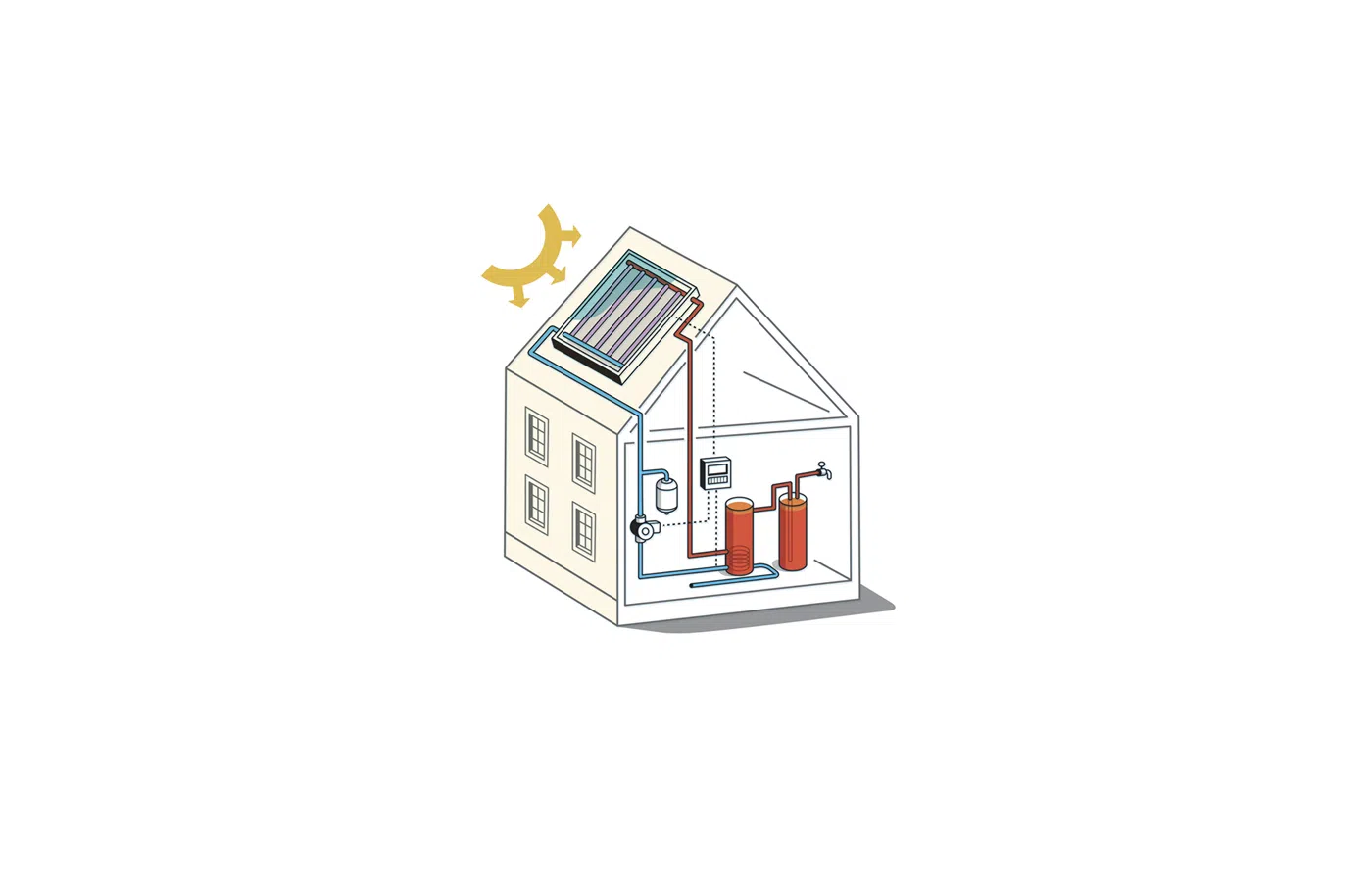Solar Hot Water
Solar hot water systems use solar energy to heat water for domestic use, reducing reliance on fossil fuels and lowering greenhouse gas emissions. Recent advancements have made these systems more efficient and affordable.

Schematic of solar hot water system (This Old House)
View open jobs in this Solution
Example Companies
- Naked Energy - Naked Energy has developed an innovative hybrid solar technology generating combined heat and power.
- SolarReserve - Develops solar thermal power projects.
- SolarCity - Provides solar energy services, including solar hot water systems.
- Viessmann - Manufactures solar thermal systems for domestic hot water and space heating.
Overview
Solar hot water systems have seen recent advancements in technology, making them more efficient and affordable. Evacuated tube solar collectors, such as those developed by SolarReserve and SolarCity, enhance solar radiation absorption, heating water for domestic use or generating electricity via solar thermal power.
- Solar Hot Water Systems - U.S. Department of Energy
- Solar Thermal Collectors - National Renewable Energy Laboratory
Progress Made
Significant advancements have been made in solar hot water technology:
- Evacuated Tube Solar Collectors: Improved absorption and reduced greenhouse gas emissions.
- Flat-Plate Collectors: Insulated glass boxes with copper pipes attached to heat-trapping absorber sheets.
- Closed Loop Systems: Circulate freeze-proof fluid through the system without touching potable water.
Solutions by Sector
Residential
- Rooftop Solar Water Heaters: Compact systems for single-family homes.
- Passive Solar Water Heating: Using natural convection to circulate water.
- Heat Pump Water Heaters: Combining solar thermal with heat pump technology.
Case Studies:
- Hawaii Solar Water Heating Program: Mandated solar water heaters in new home construction, resulting in significant energy savings (Hawaii State Energy Office).
- Australian Solar Hot Water Rebate: Government incentives led to widespread adoption of solar hot water systems in homes (Australian Government).
- California Solar Initiative-Thermal Program: Provided incentives for residential solar water heating, reducing natural gas consumption (California Public Utilities Commission).
Commercial
- Large-Scale Solar Thermal Systems: For hotels, hospitals, and multi-family buildings.
- Solar Process Heat: Using solar thermal energy for industrial processes.
- Solar Cooling: Utilizing solar heat to power absorption chillers.
Case Studies:
- Kontokosta Winery, USA: Implemented a solar thermal system for wine production processes, reducing energy costs (NYSERDA).
- Lufthansa Technik, Malta: Installed a large-scale solar water heating system for aircraft cleaning, saving 209,000 kWh annually (Enerray).
- Hôtel des Thermes Marins, Monaco: Utilizes solar thermal panels for hot water production, covering 80% of the hotel's needs (IEA SHC).
Industrial
- Solar Steam Generation: Producing high-temperature steam for industrial processes.
- Solar Desalination: Using solar energy to purify water in arid regions.
- Concentrated Solar Power: Large-scale power generation using solar thermal energy.
Case Studies:
- Sundrop Farms, Australia: Uses concentrated solar power for desalination and greenhouse climate control in tomato production (Sundrop Farms).
- Pampa Elvira Solar, Chile: Large-scale solar thermal plant providing process heat for copper mining operations (Abengoa).
- Miraah Solar Project, Oman: One of the world's largest solar plants for enhanced oil recovery, reducing natural gas consumption (GlassPoint).
Lessons Learned
Key lessons from solar hot water development:
- Clear Implementation Plans: Covering installation, maintenance, and troubleshooting is crucial.
- Costly Installation and Maintenance: Budget for the high initial costs and ongoing maintenance.
- Regular Maintenance: Essential for efficient system operation.
- Climate Suitability: Must be considered for reliable performance.
- Energy and Emissions Reduction: Solar hot water systems contribute to reducing energy consumption and emissions.
Challenges Ahead
Challenges remain in solar hot water development:
- High Initial Installation Costs: Compared to traditional water heaters.
- Sunny Location Requirement: Effectiveness is limited in less sunny locations.
- Maintenance and Cleaning Needs: Regular upkeep is necessary to maintain efficiency.
Leading Entities:
- Solar Energy Industries Association (SEIA) - Promotes solar energy and advocates for supportive policies.
- Solar Thermal Alliance (STA) - Supports the development of solar thermal technologies.
- International Renewable Energy Agency (IRENA) - Promotes the adoption of renewable energy technologies worldwide.
Best Path Forward
Solar hot water systems are cost-effective solutions for generating hot water, reducing carbon footprints, and lowering energy bills. Active and passive solar water heaters offer different circulation methods. Though they require higher initial costs, they yield significant savings in the long run.
Key Steps:
- Public Awareness: Increase awareness about the benefits of solar hot water systems through education and outreach efforts.
- Affordability: Implement financial incentives and rebates to lower the initial cost barrier.
- User-Friendly Design: Develop intuitive interfaces to enhance user experience and adoption rates.
- Policy Support: Encourage governments and businesses to adopt and promote solar hot water technologies.
- Research and Development: Support ongoing R&D to improve solar hot water technologies and integration capabilities.
Prominent supporters include the Solar Energy Industries Association, the Solar Thermal Alliance, and the International Renewable Energy Agency.
Image credit: This Old House